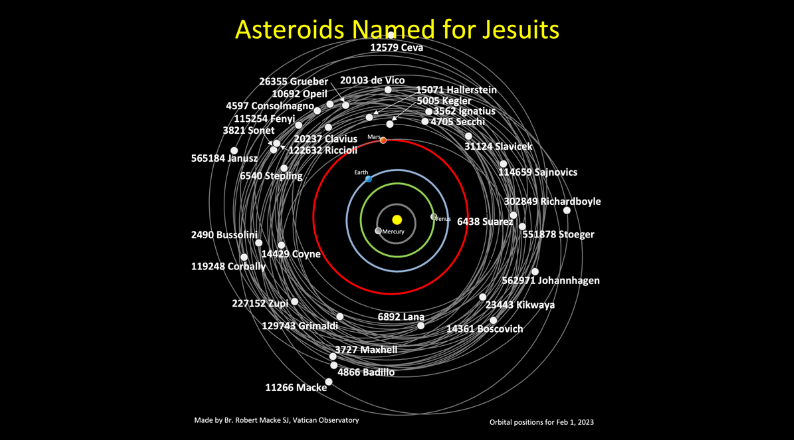(ZENIT News / Rome, 02.28.2023).- Three astronomers at the Vatican’s astronomical observatory, and a Pope with connections to the observatory, now have asteroids named after them. On February 7, 2023 the Working Group for Small Bodies Nomenclature of the International Astronomical Union published their latest batch of named asteroids (WGSBN Bulletin 3, #2), which includes:
- 562971 Johannhagen — honoring Fr. Johann Hagen (1847-1930) of the Society of Jesus (S.J.) and Director of the Vatican Observatory from 1906-1930.
- 551878 Stoeger — honoring Fr. Bill Stoeger, S.J. (1943-2014), a cosmologist and theologian at the Vatican Observatory.
- 565184 Janusz — honoring Fr. Robert Janusz, S.J. (b. 1964), currently on the staff of the observatory.
- 560974 Ugoboncompagni — honoring Ugo Boncompagni (1502-1585), Pope Gregory XIII, who directed the reform of the calendar and began the tradition of papal astronomers and observatories. He commissioned the astronomer Fr. Christopher Clavius, S.J. (who also has an asteroid named
for him — 20237 Clavius) to work on the calendar project, who then wrote the book on the operation of what is now called the “Gregorian” calendar, used worldwide today.
The four asteroids, or “minor planets”, all have connections to the Society of Jesus — the “Jesuits”. Over thirty asteroids now bear the names of Jesuits. Some are Jesuits from the centuries ago, such as Clavius, or Fr. Giovanni Battista Riccioli (1598–1671), who developed the system of lunar nomenclature that is still used today. (For example, when the Apollo 11 mission landed in the lunar “Sea of Tranquility”, that name “Tranquility” came from Riccioli.) Some, such as Janusz, are Jesuits still working today.

Because for centuries the Jesuits have travelled widely, these thirty-plus asteroids represent many different parts of the world, such as the Philippines (4866 Badillo), Paraguay (6438 Suarez), China (31124 Slavicek), Democratic Republic of Congo (23443 Kikwaya), and Argentina (2490 Bussolini).
According to the IAU, the assignment of a particular name to a particular asteroid (minor planet) comes about through a process that can, in some cases, take decades. When a new minor planet is discovered, it is given a provisional designation, based on its date of discovery, such as “2002 LM60”. When the object’s orbit is determined well enough that its position can be reliably predicted far into the future (typically after it has been observed at four or more of its closer approaches to Earth), it receives a permanent designation number, issued sequentially by the IAU’s Minor Planet Center, such as “4179”.
At this point its discoverer is invited to suggest a name for it. Names of pets or names of a commercial nature are not allowed. Names of individuals or events principally known for political or military activities cannot be used until 100 years after the death of the individual or the occurrence of the event. Naming rights cannot be purchased. Proposed names are judged by the WGSBN, which is comprised of fifteen professional astronomers from around the world with research interests connected with minor planets and comets.
Automated search efforts have discovered thousands of new asteroids, so the WGSBN must limit the numbers that receive formal names. Thus, most asteroids only receive a numerical designation.
Asteroids Johannhagen, Stoeger and Janusz join several others already named for Vatican Observatory astronomers, including 302849 Richardboyle, 119248 Corbally, 14429 Coyne, 4597 Consolmagno, 23443 Kikwaya, and 11266 Macke.



